Daru Island 1
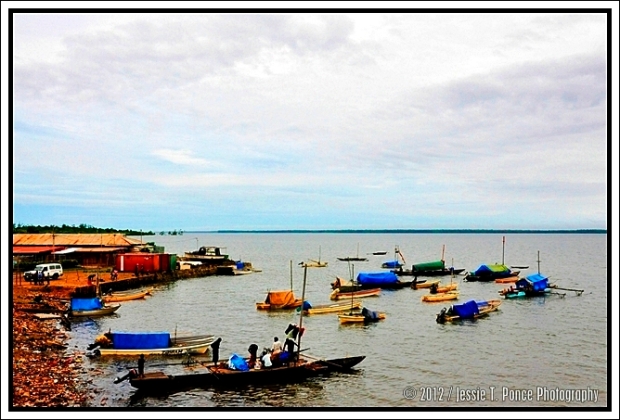
Daru Seaside
Stranded
I was on my way to Kiunga in Papua New Guinea when our plane had to make an emergency landing on the island of Daru because of fuel leaking into the cabin. It was a scary moment landing into the Daru airstrip knowing that the plane was dripping with highly flammable fuel and a small spark during landing could catch fire and blow us up into pieces. Thankfully, we landed safely although it meant that I had to wait for two days on the island for the next flight that would bring me to Kiunga.
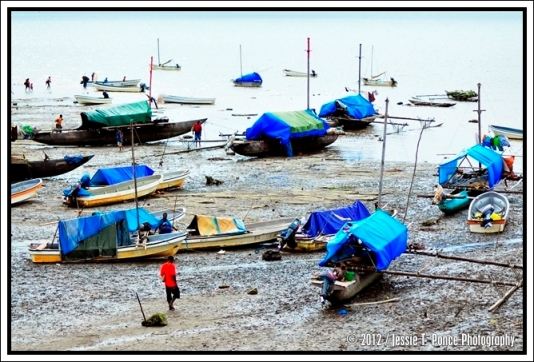
The Daru seaside is filled with dugout canoes which become the temporary home of traders from villages at the mainland
Daru is just a small island in the Gulf of Papua near the mouth of the Fly River. It used to be the capital of the Western Province but, in recent years, most government agencies have moved their offices to Kiunga where the biggest industries in the region, particularly the mines and rubber plantations, are located.
Photo Op
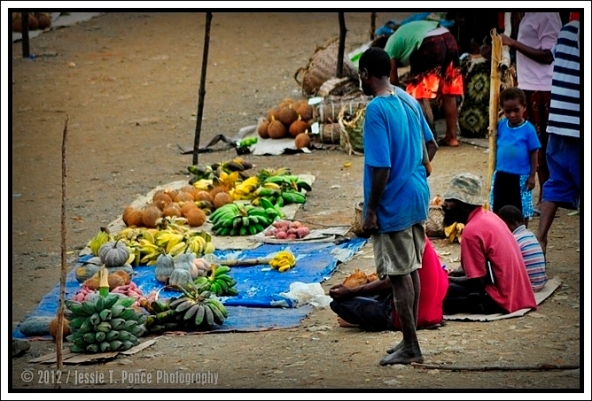
The traders’ goods — sago, bananas, coconuts, vegetables, fish and jungle meat — are displayed in a makeshift market by the seaside
Being stranded on the island wasn’t too bad. Daru was part of my travel itinerary for the following week and I just made arrangements for my appointments to be moved forward since I was already on the island. The itinerary included visits to nearby villages and that also excited me because it gave me a glimpse of village life along the coast in contrast to those further inland in the jungles closer to Kiunga. Of course, it was also a wonderful opportunity to take photos.
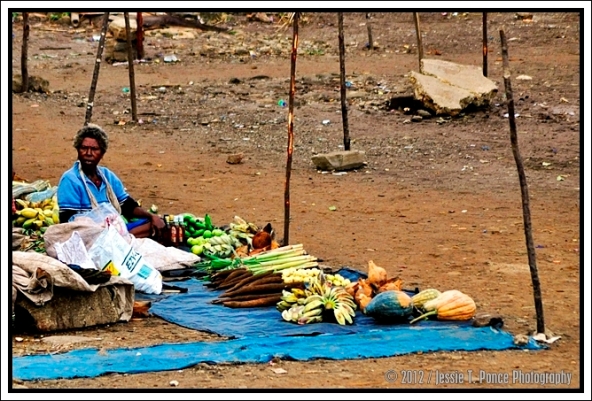
The goods being displayed are almost the same among all the traders. This lady waits for early customers
The lodging house where I stayed, the “biggest hotel” in town called New Century, offered a further bonus. Although it was a simple affair, it has a wide balcony that offered a great view of the gulf and the mainland across the channel (first photo) as well as the busy seaside and colorful local market just below the balcony. And, since the visit inadvertently happened ahead of schedule, I found some extra time which I mostly spent on the balcony chatting with locals and other guests and photographing whatever caught my attention from my vantage point.
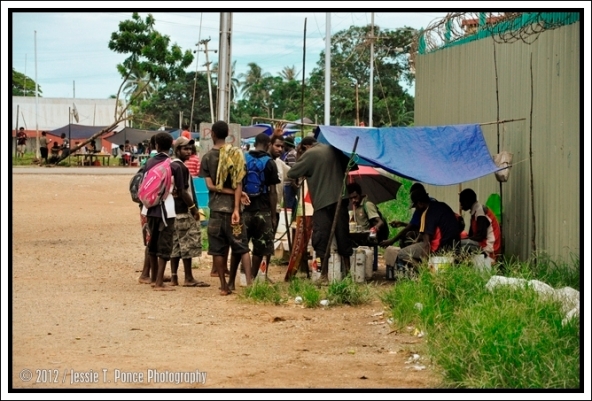
In another corner, buyers compete for the scarce and expensive fuel for their outboard motors. Sometimes supplies run out and traders get stranded on the island.
The seaside below the balcony was always teeming with activity. Viewing it from an elevated position felt like watching a movie except that this one was live and the pattern kept on unfolding with every turn of the tide. Motorized dinghies and canopied dugouts were always present on the seaside high tide or low tide, rain or shine, day or night. As a dinghy or dugout left, another one arrived.
The vacant lot by the seaside also followed a daily cycle. As the sun rose, poles sprung from the ground and grew canopies of blue plastic sheets under which piles of basic local food stuff get displayed and around which locals and visitors mill to buy their food for the day. And then, as the sun set, the makeshift stalls also went down only to arise once again the next day.
Subsistence
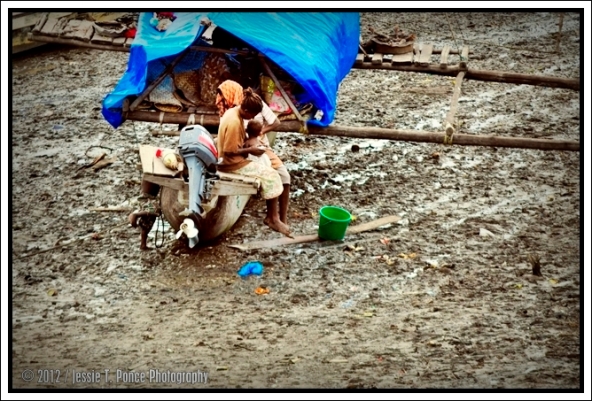
And, by the muddy shores, mothers care for their babies who will soon inherit the boat and this form of subsistence.
What I was witnessing by the balcony was in fact an important economic pattern in the region. What the boats brought in represented almost everything that the villages at the mainland are able to produce. And they are not much. Coastal villages brought in fish or shrimps; villages further inland brought in sago, bananas, coconuts, vegetables and meat from whatever animals they have caught — deer, cassowary, crocodile, etc. They come to Daru Island with their products, most of the time accompanied by their whole family.
And so the boats become their temporary home while they are on the island. Children played on the muddy shore as their parents traded and haggled for their goods at the makeshift market. Mothers bathed and fed their young under the boats’ canopies as their husbands sought supplies to bring home. And when they have sold out their products — sometimes after several days — they pack their supplies and sail back to their villages where they will gather as much food stuff until they have collected enough to be delivered to Daru once again. And this vicious subsistence cycle went on as politics dominated the discussion of the leaders who also watch the activity from the balcony from time to time.
Related articles
- A Papuan Seascape 1 (travellingartist.wordpress.com)
- The Mighty Fly River (travellingartist.wordpress.com)
- Village Life 1 (travellingartist.wordpress.com)
- Village Life 2 (travellingartist.wordpress.com)
- Dug-out 1 (travellingartist.wordpress.com)
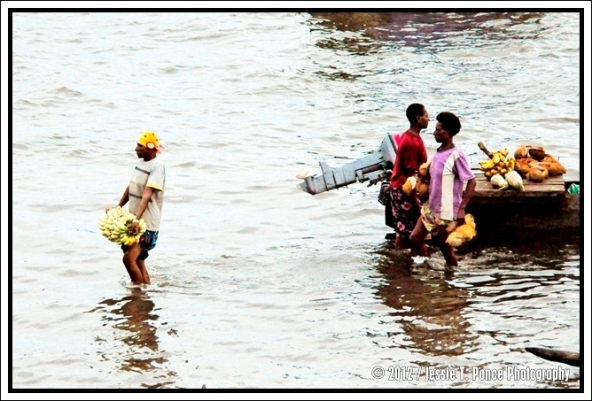
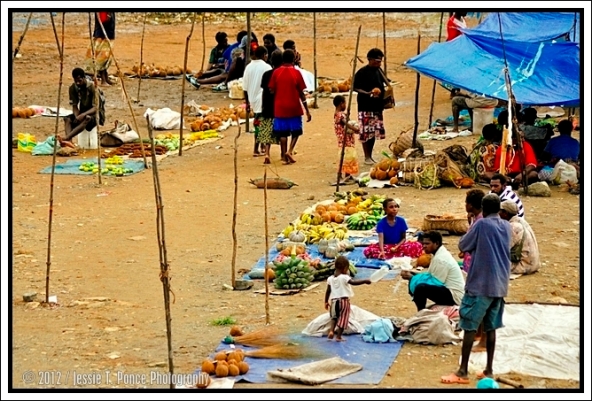
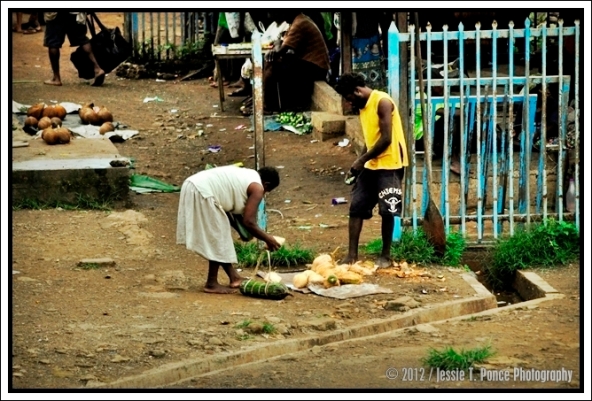
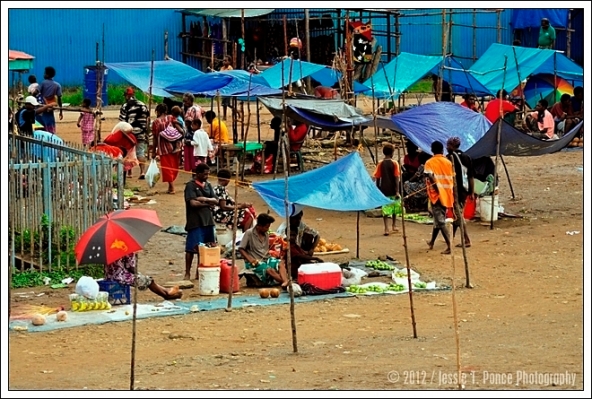
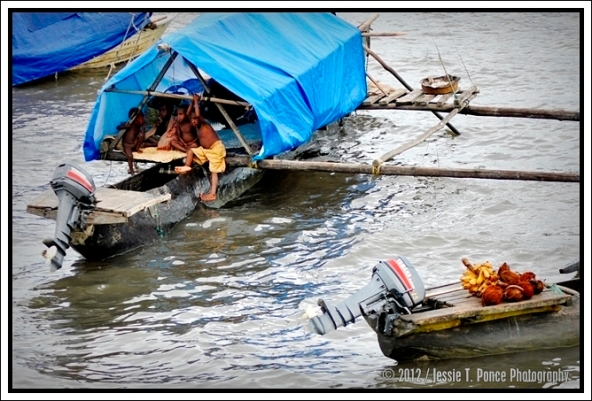










You’re really good at getting these photos and giving us a true feeling of what it’s like there. I hope someday these beautiful people will find a way to thrive, not just survive.
LikeLike
Thanks, Gina. I just love to capture slices of life through my lens and I share your hope for all peoples.
LikeLike
Safe travels and be well, Jessie.
LikeLike
Love the scenes. Local flavor is always very interesting for me. Thank you for sharing.
LikeLike
Hi Jojie. Honored by your visit and thanks for the kind comment.
LikeLike
Thanks for sharing this story. Before the section about subsistence I was thinking that this life might look very casual and “free” to some, but I figured it likely they are all just scraping by. And then you confirmed it. Wonderful photographs, as always. And again, thank you for the information you bring to your photographs. Context is everything.
LikeLike
Hi, bluelyon. Maybe this group is contented with this way of life and they just have simple aspirations — I really can’t tell. I think a lot of ‘our’ worries are caused by huge ambitions and being insatiable 🙂
Thanks for your comment and I agree with you, context is everything.
LikeLike
Really interesting, and great photos.
LikeLike
Thanks a lot, Naomi.
LikeLike
haha…in our language Daru means Alcohol 😉
LikeLike
I captured some images of people enjoying alcohol but, other than that, the island was pretty sober to me 🙂 Thanks for visiting, Namita.
LikeLike
What an adventure … leaking fuel, wonderful spot to land on and some stunning photos to share with us. Thank .. you, a very colorful place.
LikeLike
Thanks, viveka.
LikeLike
I would have loved to hear the political discussion. How does one change a culture? Does one change a culture? To what purpose? To make them more like westerners or any wealthier nation group? To try to solve the difficult issues of poverty, depravation, disease? Lots of questions – are there any answers?
Thanks for the glimpse into PNG & her people.
LikeLike
Some very important questions, T Hollis. My personal view on development is not to change culture or ‘Westernize’ the people but just start with helping the poor improve their livelihoods to a more sustainable level, or to help them ‘thrive, not just survive’ as Gina mentioned above. But, as you suggests, there are no definite answers to all these questions and there is no standard formula to address issues of poverty and deprivation.
Thanks for sharing your thoughts. I truly appreciate your deep reflections on this post. Regards.
LikeLike
Eeeek!!! That must be scary. Glad to hear your okay.
A disaster turned into travel oppurtunity that actually saves you time and money. Whatta incident!
Great images as always.
LikeLike
Thanks, Rommel. Incidents like this are what make adventures more exciting and memorable. Regards.
LikeLike
Pingback: Picnic | A Traveller's Tale
I’m glad you didn’t blow up when you touched down. Great images, and the narrative gave me a good sense of being there too. Great job!
LikeLike
Yeah, the incident just spiced up the adventure and paid me up with great photo ops. Thanks a lot, Stephen.
LikeLike
Pingback: A Papuan Seascape 3 « A Traveller's Tale
Pingback: Children of Papua 10 « A Traveller's Tale
Pingback: Daru Island 2 « A Traveller's Tale
Pingback: Dugout 7 « A Traveller's Tale
Pingback: Market « A Traveller's Tale
Pingback: Port Moresby « A Traveller's Tale
Pingback: The Jelly Experience [Exhibit 1] « The Sophomore Slump
Pingback: Dugout 9 « A Traveller's Tale
Hi! Just letting you know that I featured your blog to one of my post. ;D
LikeLike
Oooppss, Sorry didn’t catch that soon enough. Thanks a lot!
LikeLike
Pingback: Children of Papua 16 « A Traveller's Tale
I lived on Daru for 5 years when I was a child, looks like it hasn’t changed ! My Dad was the regional agricultural officer and helped pioneer a lot of the country in the Strickland area, Kiunga and border.
LikeLike
Wow! I real pioneering experience as a child. I envy you! Must have been a lot more difficult especially in terms of accessibility then.
LikeLike
hi my name is stahl patrick may and am from daru and to be very honest i am a daru grown kid and if you think that your missing daru and you want to come garanty you that if you ever set footon this island you would want to check out the diffrent kind of food that sold and the same kind of food that we eat. thanks and love you all for your comments
LikeLike
hello, stahl patrick may. it’s really great to meet somebody from daru on the internet. i must tell you that i really enjoyed my time in daru and I would like to visit again. will tell you if i’ll have a chance and yes, i’ll be interested in local food stuff. thanks for visiting and letting me know you were here. regards, 🙂
LikeLike
Pingback: Daru Island: On Muddy Shores | A Traveller's Tale
Pingback: A River Scene 1 | A Traveller's Tale
Pingback: The Mighty Fly River 2 | A Traveller's Tale
I lived in Daru from 1992 until 1997 and got to see first hand the life style your picture cupture. Even though the people have very little in material wealth, they are happy and content. Living and working among the coastal people of Western Province were some of the rewarding experiences of my life, and I enjoyed my time there.
LikeLike
Pingback: Daru – Back on the Island | A Traveller's Tale
Pingback: The Fly River Delta | A Traveler's Tale